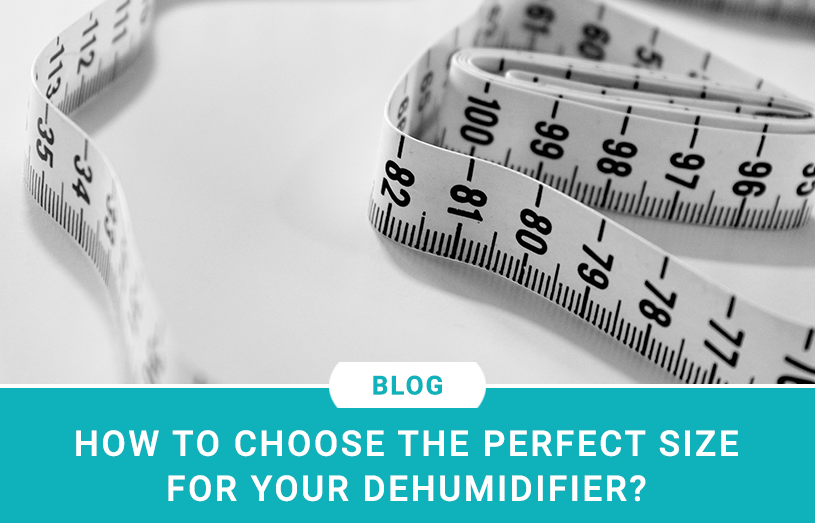Maybe you have heard a lot of things about dehumidifiers and you’re interested in them, but you need additional advice. Maybe you know the important info, but you want to make sure that you got everything right before you invest and create a purchase.

Whatever it is, we’re going to go through some basics about getting a dehumidifier, but we’ll focus on one question specifically: what’s the right size to go with? If you want a more generic guide, we suggest you do a bit of searching on our website.
How are dehumidifiers labeled according to size?
This is a really simple thing that actually creates a lot of trouble amongst people because they don’t know what unit of volume or surface or mass they are looking at. The most important three parameters you need to know are time, surface and pints.
Time. You want to know how long can a dehumidifier run. What’s the use of having a gadget that covers 100 square feet if it cannot work for more than 3 hours? You should aim for those that work at least 8, but those that can push up to 12 are usually a much better deal.
Surface. Let’s not confuse our measurements: we’re talking about the surface that one dehumidifier covers, not a surface of the dehumidifier itself. This will be better explained later in the next few paragraphs.
Pints. A pint is an interesting unit of measurement that we see quite often in the world of volume. It can equal to a glass and, depending on your location, it goes from 330 mL to 600 mL in volume. Each dehumidifier is labeled with the number of pints it can filter daily, and we’re surely talking about water here.
Where do you use your dehumidifier?
If you’re looking for a dehumidifier, the first thing you should ask yourself is where you’re going to use it. This will create a difference in the function, but also in the efficiency. You surely don’t want to overpay a dehumidifier for some extra features you do not need.
For this, you will have to figure out the square feet you want covered. This is easy, just multiply the width and the length of the room. Many manufacturers will state the amount of surface a product can cover, so this is a good guideline.
How bad is the situation?
Each case can be very different and for all, we know you may have a huge room that’s not very damp and a small room that’s dripping. Of course, this will change the type of a product you need and that’s why you should get a humidistat to tell you how far off are you from the 50% that you need to aim for.
If you’re between 50 to 60 percent, you should go for a 30-70 pint machine. If the area is anywhere between 500 and 1000 square feet, look for about 50. For those that are 1500 square feet, 70 does the job.
If you’re almost reaching the 70%, you should up the numbers mentioned up there by 10, and if you’re going up to 85, by 20. If you have a space that’s above 85% of humidity, you are looking for 45-100 pints, according to the size of the room.
Small details matter
There are also some extra points that you get according to the environment around you and the little things that change the terms of a household.
If you live in a humid climate where rain and show are very often, you should go 10 pints up from the recommended amount.
If there are more than 2 people in your living space, add 5 pints to be sure. We all evaporate water as well, and that can change according to the seasons.
If you have a lot of doors and windows, this is also probably allowing the humidity to enter your home. For that, you add another 5 pints on top.
In the case of a bathroom or a basement dehumidifier, you should add 5 pints because of the washer and the dryer that tend to create trouble on their own.
Temperature is also important. If you want to keep the temperature in your home at the same amount, it’s best to get a dehumidifier with a large capacity so it can always run and never change the current state that you have set up as a combination of events.
If you live near the sea or a big river or a lake, add 5 pints. Even bigger fountains can add up to the humidity, so make sure that you add 10 if you feel like 5 is not enough.
Don’t go overboard with the settings
While it’s never too bad to have a dehumidifier that can do a lot of things in one day, it’s not smart to jam up the settings all the way down and suddenly live in Sahara air. Try to aim for 50-55, depending on the members of the household and the current health status that everyone has.
Summary
The size of a dehumidifier isn’t really set by the dimensions or the mass of it, but by the surface it can cover and the pints it can take out from the air daily. That’s why the calculation is a bit more complex and you have to take into account both the size of your room, the temperature of it, the country where you live, whether you are surrounded by water or not and more.
Make sure to consult with someone who is already familiar with these machines or just check them out on the Internet to get an idea of which features come at what price points. In the end, don’t go mad with the settings and always go baby steps when you’re trying out something new.




